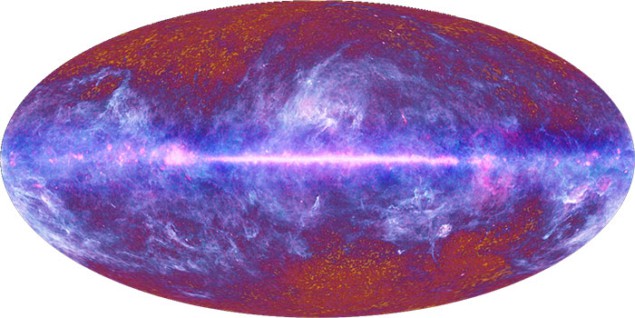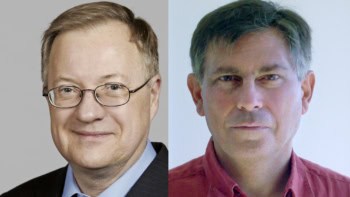
The conservation of energy is one of physicists’ most cherished principles, but its violation could resolve a major scientific mystery: why is the expansion of the universe accelerating? That is the eye-catching claim of a group of theorists in France and Mexico, who have worked out that dark energy can take the form of Albert Einstein’s cosmological constant by effectively sucking energy out of the cosmos as it expands.
The cosmological constant is a mathematical term describing an anti-gravitational force that Einstein had inserted into his equations of general relativity in order to counteract the mutual attraction of matter within a static universe. It was then described by Einstein as his “biggest blunder”, after it was discovered that the universe is in fact expanding. But then the constant returned to favour in the late 1990s following the discovery that the universe’s expansion is accelerating.
For many physicists, the cosmological constant is a natural candidate to explain dark energy. Since it is a property of space–time itself, the constant could represent the energy generated by the virtual particles that quantum mechanics dictates continually flit into and out of existence. Unfortunately the theoretical value of this “vacuum energy” is up to a staggering 120 orders of magnitude larger than observations of the universe’s expansion imply.
Running total
The latest work, carried out by Alejandro Perez and Thibaut Josset of Aix Marseille University together with Daniel Sudarsky of the National Autonomous University of Mexico, proposes that the cosmological constant is instead the running total of all the non-conserved energy in the history of the universe. The “constant” in fact would vary – increasing when energy flows out of the universe and decreasing when it returns. However, the constant would appear unchanging in our current (low-density) epoch because its rate of change would be proportional to the universe’s mass density. In this scheme, vacuum energy does not contribute to the cosmological constant.
The researchers had to look beyond general relativity because, like Newtonian mechanics, it requires energy to be conserved. Strictly speaking, relativity requires the conservation of a multi-component “energy-momentum tensor”. That conservation is manifest in the fact that, on very small scales, space–time is flat, even though Einstein’s theory tells us that mass distorts the geometry of space–time.
Even though each individual violation of energy conservation is tiny, the accumulated effect of these violations over the very long history of the universe can lead to dark energy
Alejandro Perez, Aix Marseille University
In contrast, most attempts to devise a theory of quantum gravity require space–time to come in discrete grains at the smallest (Planck-length) scales. That graininess opens the door to energy non-conservation. Unfortunately, no fully formed quantum-gravity theory exists yet, and so the trio instead turned to a variant of general relativity known as unimodular gravity, which allows some violation of energy conservation. They found that when they constrained the amount of energy that can be lost from (or gained by) the universe to be consistent with the cosmological principle – on very large scales the process must be both homogeneous and isotropic – the unimodular equations generated a cosmological-constant-like entity.
Modified quantum mechanics
In the absence of a proper understanding of Planck-scale space–time graininess, the researchers were unable to calculate the exact size of the cosmological constant. Instead, they incorporated the unimodular equations into a couple of phenomenological models that exhibit energy non-conservation. One of these describes how matter might propagate in granular space–time, while the other modifies quantum mechanics to account for the disappearance of superposition states at macroscopic scales.
These models both contain two free parameters, which were adjusted to make the models consistent with null results from experiments that have looked for energy non-conservation in our local universe. Despite this severe constraint, the researchers found that the models generated a cosmological constant of the same order of magnitude as that observed. “We are saying that even though each individual violation of energy conservation is tiny, the accumulated effect of these violations over the very long history of the universe can lead to dark energy and accelerated expansion,” Perez says.
In future, he says it might be possible to subject the new idea to more direct tests, such as observing supernovae very precisely to try to work out whether the universe’s accelerating expansion is driven by a constant or varying force. The model could also be improved so that it captures dark-energy’s evolution from just after the Big Bang – and then comparing the results with observations of the cosmic microwave background.
If the trio are ultimately proved right, it would not mean physicists having to throw their long-established conservation principles completely out of the window. A variation in the cosmological constant, Perez says, could point to a deeper, more abstract kind of conservation law. “Just as heat is energy stored in the chaotic motion of molecules, the cosmological constant would be ‘energy’ stored in the dynamics of atoms of space–time,” he explains. “This energy would only appear to be lost if space–time is assumed to be smooth.”
Fanciful yet viable
Other physicists are cautiously supportive of the new work. George Ellis of the University of Cape Town in South Africa describes the research as “no more fanciful than many other ideas being explored in theoretical physics at present”. The fact that the models predict energy to be “effectively conserved on solar-system scales” – a crucial check, he says – makes the proposal “viable” in his view.
Lee Smolin of the Perimeter Institute for Theoretical Physics in Canada, meanwhile, praises the researchers for their “fresh new idea”, which he describes as “speculative, but in the best way”. He says that the proposal is “probably wrong”, but that if it’s right “it is revolutionary”.
The research is described in Physical Review Letters.



